Welcome to Shuangzi Shan , a Temperate island in the Eastern China Sea, part of the majestic Pacific Ocean. This guide offers a comprehensive overview of what makes Shuangzi Shan unique – from its geography and climate to its population, infrastructure, and beyond. Dive into the details:
Geography and size of Shuangzi Shan
Size: 0.85 km²Coastline: 7 kmOcean: Pacific OceanSea: Eastern China SeaContinent: Asia
Shuangzi Shan is a Tiny Island spanning 0.85 km² with a coastline of 7 km.
Archipel: –
Tectonic Plate: Yangtze – A minor tectonic plate in East Asia, often considered a part of the Eurasian Plate. It’s primarily continental and covers the Yangtze River area in China, playing a significant role in the region’s geological stability.
The geographic heart of the island is pinpointed at these coordinates:
Climate and weather of Shuangzi Shan
Climate Zone: TemperateClimate Details: Humid Subtropical ClimateTemperature: Hot Summer
Climate Characteristics: With continuous rainfall and hot summers, this climate is common in some coastal regions, supporting diverse vegetation.
Topography and nature of Shuangzi Shan
Timezone: UTC+08:00Timezone places: Australia/PerthMax. Elevation: 3 m Mean Elevation: 0 mVegetation: Sparse VegetationTree Coverage: 60%
The mean elevation is 0 m. The highest elevation on the island reaches approximately 3 meters above sea level. The island is characterized by Plains: Flat, low-lying lands characterized by a maximum elevation of up to 200 meters. On islands, plains are typically coastal lowlands or central flat areas.
Dominating Vegetation: Sparse Vegetation
Vegetation: 1 vegetation zones – Minimal Diversity Island
Infrastructure and Travelling to Shuangzi Shan
Does the island have a public airport? no .
Does the island have a major port? no .
The mean population of Shuangzi Shan is 803 per km². Shuangzi Shan is Densely Populated. The island belongs to China .
Continuing your journey, Qushan Dao is the next notable island, situated merely km away.
Battle Through the Heavens, the world's first Combat Qi idle RPG mobile game is now officially launched! Come and cultivate with ...
ENG SUB | Battle Through the Heavens Year Version Ⅲ Full Version | EP 175 - 226 | Yuewen Animation
Battle Through the Heavens, the world's first Combat Qi idle RPG ...
Battle Through the Heavens, the world's first Combat Qi idle RPG mobile game is now officially launched! Come and cultivate with ...
Course 1, Preview 7: The Alchemy of the Organs – The Heart Meditation in Zhuangzi w/ Peter Firebrace
This is a short excerpt from the recorded seminar with Peter ...
This is a short excerpt from the recorded seminar with Peter Firebrace, presenting his Alchemy of the Organs Course – The Red ...
《五千年中华历史》第九集《大禹治水》夏朝时期,据说尧舜时代正值冰河时代后期,气候转暖冰雪消融,致使海平面迅速升高,海水倒灌;古黄河改道从苏北平原入海,淮河淤积,汹涌的洪水淹没了...
《五千年中华历史》第九集,《夏朝》.据说尧舜时代正值冰河时代后期,气候转暖冰雪消融,致使海平面迅速升高,海水倒灌; ...
《五千年中华历史》第九集,《夏朝》.据说尧舜时代正值冰河时代后期,气候转暖冰雪消融,致使海平面迅速升高,海水倒灌; ...
China is classified as Emerging region: BRIC: Brazil, Russia, India, and China – Economies noted for their rapid growth and increasing influence on global affairs. The level of income is Upper middle income.
News – Latest Updates and Headlines from Shuangzi Shan
Stay informed with the most recent news and important headlines from Shuangzi Shan. Here’s a roundup of the latest developments.
Loading...
Please note: The data used here has been primarily extracted from satellite readings. Deviations from exact values may occur, particularly regarding the height of elevations and population density. Land area and coastline measurements refer to average values at mean high tide.

